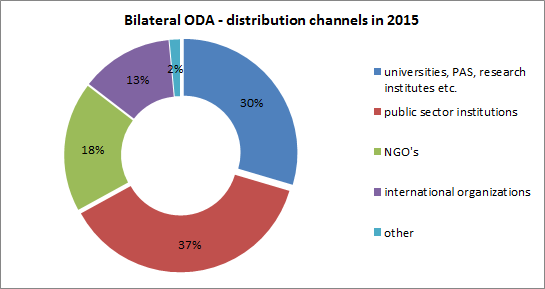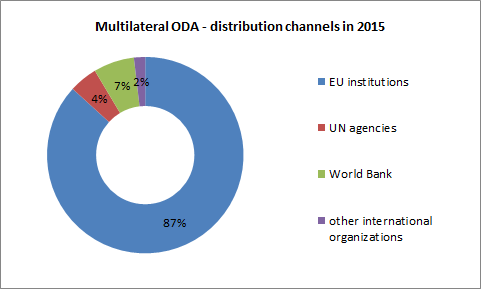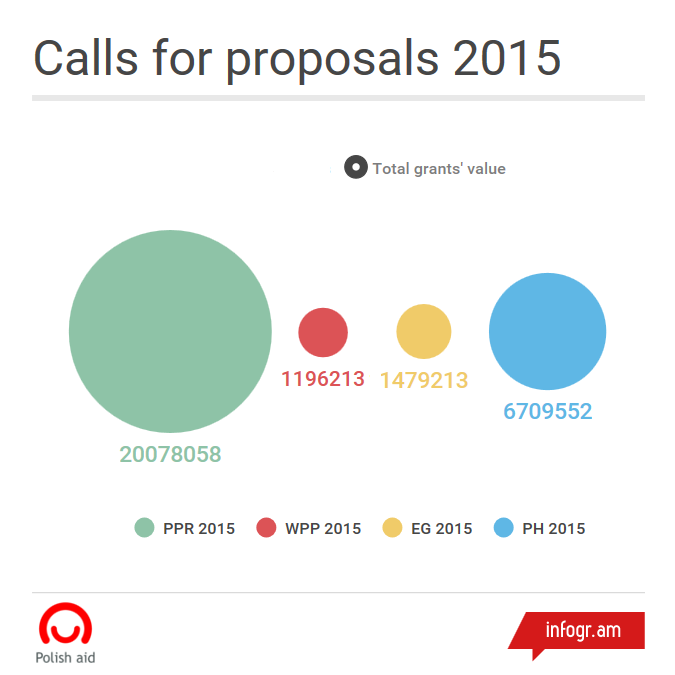Polish Aid 2015 in numbers
Bilateral and multilateral Official Development Assistance (ODA)
In 2015, Poland provided PLN 1.662 billion for Official Development Assistance (ODA), which included PLN 1.284 billion, i.e. 77% of all funds, spent for multilateral cooperation. PLN 378 million (23%) was spent on bilateral cooperation. After deducting the value of loan agreements, the value of bilateral assistance reached PLN 315 million. The amounts spent on development cooperation amounted to 0.1% of Poland’s Gross National Income (GNI).
The largest part of Polish development assistance spent via multilateral institutions and organisations fed the European Union funds intended for external development assistance. In 2015, the value of Poland’s share in those activities amounted to PLN 1.115 million. It included a part of the contribution to the EU budget, which was dedicated to the above-mentioned purpose (PLN 926 million[1]) and the payment for the European Development Fund (EDF) (PLN 189 million[2]) which is the main non-budgetary instrument of the European Union used to finance the cooperation with countries in Africa, the Caribbean, and the African, Caribbean and Pacific Group of States (ACP) and Overseas Countries and Territories (OCTs).
Entities acting within the United Nations System were provided with PLN 60 million and those acting with World Bank with PLN 86 million.
Geographical and thematic areas
In 2015, the development assistance was based on the Multiannual Development Cooperation Programme 2012–2015. Pursuant to the programme, Polish assistance was provided within geographical and thematic support areas.
Geographical areas were divided into two groups. The first group comprised the six countries of the Eastern Partnership: Armenia, Azerbaijan, Belarus, Georgia, Moldova, and Ukraine. In this case, the purpose of Polish assistance is supporting the continuous and stable functioning of democratic systems, ensuring that human rights are respected, and contributing to effective system transformation.
The other group includes selected countries of Africa, Asia, and the Middle East. It comprises eight countries from Eastern Africa (Burundi, Ethiopia, Kenya, Rwanda, Somalia, South Sudan, Tanzania, and Uganda), two countries from Central Asia (Kyrgyzstan and Tajikistan), and Palestine. The countries listed above suffer from a high level of poverty.
The main recipients of Poland’s bilateral assistance in 2015 were: Ukraine (PLN 108.78 million), Ethiopia (PLN 102.88 million), Belarus (PLN 70.77 million), Angola (PLN 52.20 million), Syria (PLN 11.18 million), Moldova (PLN 9.27 million), Georgia (PLN 7.49 million), Kazakhstan (PLN 4.08 million), Palestine (PLN 3.89 million) and Cambodia (PLN 3.74 million).
Since the implementation of the 2012–2015 Programme, Polish development assistance has been concentrated on two thematic support areas, i.e. democracy and human rights, and system transformation.
Education has also been an important aspect of Polish development assistance. In 2015, the amount spent on education, including scholarships, reached PLN 131.3 million (excluding credit aid). Another significant component of ODA was supporting the government sector and the civic society (PLN 70.85 million).
Poland contributed in 2015 to humanitarian activities as a part of ODA nearly PLN 25 million. Main groups of recipients in 2015 included Ukrainians and Syrians.
Calls for proposals
In 2015 the MFA’s Department of Development Cooperation organized 5 open calls for proposals. Taking into account final results of those proceedings and implementation of second modules of projects chosen in calls for proposals Polish Development Assistance 2014 and Global Education 2014, co-financing, which totaled 32 684 996 PLN was provided for 110 projects, which include:
-
- Call for proposals “Polish Development Assistance 2015” – 20 078 058 PLN (56 projects)
- Call for proposals “Polish Development Assistance 2014” (second module) – 2 101 173 PLN (5 projects)
- Call for proposals “Polish Aid Volunteering Programme 2015” – 1 196 213 PLN (22 projects)
- Call for proposals “Global Education 2015” – 1 479 757 PLN (14 projects)
- Call for proposals “Global Education 2014” (second module) – 1 120 243 PLN (5 projects)
- Call for proposals “Humanitarian Aid 2015” – 5 726 382 PLN (6 projects)
- Call for proposals “Humanitarian Aid for Ukraine 2015" – 983 170 PLN (2 projects)
Distribution channels
The main distribution channels included universities, and scientific and R&D institutions. Almost 37% of funds intended for bilateral development assistance was provided in this way. The second largest group consisted of institutions in the public finance sector, mostly ministries and foreign offices, which spent more than 30% of the funds. Non-governmental organisations which implemented actions amounting to almost 18% of bilateral assistance played an important role, as well. The remaining funds, 13% of the value of bilateral ODA minus loan agreements, were spent via international organisations.
[1] Poland pays one contribution to the EU budget. The contribution is not divided into particular programmes, funds, or instruments. Poland’s share in the Official Development Assistance of the European Union is calculated as follows: the percentage of the EU budget that is contributed by Poland can be calculated on the basis of the EU budget amount and the amount contributed by Poland. Assuming that Poland’s share in the Official Development Assistance of the European Union is the same as its share in the entire EU budget, it can be calculated on the basis of the data on the EU budget implementation. Estimates on budget implementation are updated as new reports and EU reports are filed, and therefore can be subject to change.
[2]The amounts contributed by the Member States to the European Development Fund is specified by the European Commission each time based on the estimated financial needs related to the activities provided for in a given edition of the Fund. Funds unused in a given edition are not returned to their contributors. Instead, they are credited towards the amount due for the following Fund edition.


